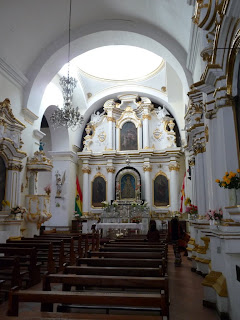El día de Santa Clara

Last Wednesday, as a break from the Archives, I decided to visit the Museo del Convento de Santa Clara. Much smaller than the Museo de Santa Teresa in Potosí, the local museum has a small but excellent collection of 18th century paintings, sculpture and silverwork. On my way out of my B&B, I mentioned Santa Clara to my landlord, Osvaldo, and he asked me if I was going to pick up some of their famous empanandas (filled meat or cheese pies) which hadn't occurred to me, but...
When I entered, I realized that I would not be allowed to take photographs. The ticket seller/guide (I was the only visitor) indicated I needed to go around the corner to request permission. I expected I would find something like an office where I could plead my case. Instead, off to the side of a small courtyard was a staircase, a large landing and a number of people standing in line to buy empanadas. Not seeing any other possibility, I joined the line. When the nun, behind a small green wooden revolving door asked me how many I wanted. I said none, thank you, but I would like permission to take photographs in the museum. She said a nun would meet me in the museum. I returned to the museum, presented my card and explained why I needed the pictures and that I would not use flash. She agreed but suggested I make a contribution to the museum which I did. At that point, the once officious guide became my gracious assistant.
This morning, I was invited to my friend Darío's Mother's house for the Canseco annual participatory Empanadas de Santa Clara bake. We all helped roll the dough, stuff, finish the edges and bake. When they were fresh from the oven, there were more than 25 of us feasting. The filling consisted of sautéed green onions, hardboiled eggs and olives cured in red wine. Of course they were delicious. I hadn’t realized that Wednesday was Santa Clara's saint’s day and the one day in the year that the Santa Clara nuns offer their famous empanadas to the public.
By the way, as I left the museum, I asked the guide if the nuns ever offered him an empanada. He said no, so I went back to the green rotating door and bought two for each of us.
















